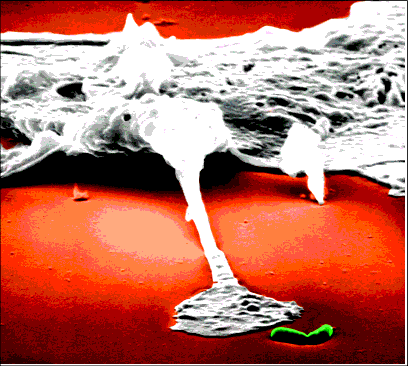37. Sexual Reproduction
If sexual reproduction in plants, animals, and humans is a result of evolutionary sequences, an unbelievable series of chance events must have occurred at each stage.
a. The amazingly complex, radically different, yet complementary reproductive systems of the male and female must have completely and independently evolved at each stage about the same time and place. Just a slight incompleteness in only one of the two at any stage would make both reproductive systems useless, and the organism would become extinct.
b. The physical, chemical, and emotional systems of the male and female would also need to be compatible.a

Figure 18: White Blood Cell. A white blood cell is stalking the green bacterium shown at the lower right. Your health, and that of many animals, depends on the effectiveness of these “search-and-destroy missions.” Consider the capabilities and associated equipment this white blood cell must have to do its job. It must identify friend and foe. Once a foe is detected, the white blood cell must rapidly locate and overtake the invader. Then, the white blood cell must engulf the bacterium, destroy it, and have the endurance to repeat this many times. Miniaturization, fuel efficiency, and compatibility with other parts of the body are also key requirements. The equipment for each function requires careful design. Unless all this worked well from the beginning of life, a requirement that rules out evolution, bacteria and other agents of disease would have won, and we would not be here to marvel at these hidden abilities in our bodies.
A few “stem cells” in your bone marrow produce more than 100 billion of these and other types of blood cells every day. Each white blood cell moves on its own at up to 30 microns (almost half the diameter of a human hair) each minute. So many white blood cells are in your body that their total distance traveled in one day would circle Earth twice. © Boehringer Ingelheim International GmbH; photo by Lennart Nilsson.
c. The millions of complex products of a male reproductive system (pollen or sperm) must have an affinity for and a mechanical, chemical,b and electricalc compatibility with the eggs of the female reproductive system.
d. The many intricate processes occurring at the molecular level inside the fertilized egg would have to work with fantastic precision—processes that scientists can describe only in a general sense.d
e. The environment of this fertilized egg, from conception through adulthood and until it also reproduced with another sexually capable adult (who also “accidentally” evolved), would have to be tightly controlled.
f. This remarkable string of “accidents” must have been repeated for millions of species.
Either this series of incredible and complementary events happened by random, evolutionary processes, or sexual reproduction was designed by intelligence.
Furthermore, if sexual reproduction evolved even once, the steps by which an embryo becomes either a male or female should be similar for all animals. Actually, these steps vary among animals.e
Evolution theory predicts nature would select asexual instead of sexual reproduction.f If asexual reproduction (splitting an organism into two identical organisms) evolved before sexual reproduction, how did complex sexual diversity arise—or survive?
If life evolved, why would any form of life live long beyond its reproductive age, when beneficial changes cannot be passed on? All the energy expended, supposedly over thousands of years and many evolutionary stages, to allow organisms to live beyond reproductive age would be a waste, until the evolutionary advantage had completely evolved. For example, Why do human females live past menopause? If there is no potential for reproduction, then according to evolution, there is no evolutionary reason to exist.
Darwin’s statement on page 20, can be generalized by adding the words in brackets:
If it could be demonstrated that any complex organ [or capability] existed which could not possibly have been formed by numerous successive, slight modifications, [none of which is harmful] my theory would absolutely break down.
Finally, to produce the first life form would be one miracle. But for natural processes to produce life that could reproduce itself would be a miracle on top of a miracle.g